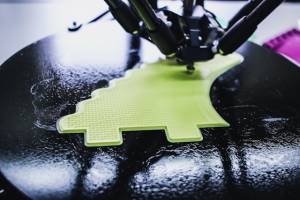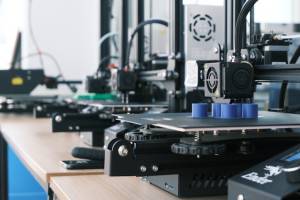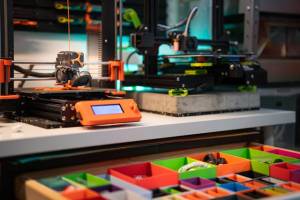3D printing makes production more agile, efficient, and adaptive. Along with its numerous creative applications, 3D printing is great at manufacturing eco-friendly items and may lead to more sustainable production.
Sustainability requires efficiency. Energy and material efficiency and a circular economy where products are reused and rebuilt are advocated.
Sustainability may be promoted by using 3D printing in numerous industries and at all stages of production, from prototype to finished product. CNC machining specialists Rotec authored this article on 3D printing’s greener production future so read on.
3D Printing reduces Waste and Overstocking

3D printing aids green production. Grinding and cutting remove raw materials from a larger component to make a finished product in traditional manufacturing. Naturally, this operation may generate a lot of waste.
Three-dimensional printing puts material layer by layer to build a final product using detailed designs. waste management improves quickly, and the process’s accuracy saves resources and energy, making manufacturing greener.
Conservation of energy is another sustainability factor. 3D printing reduces energy use by simplifying manufacturing and eliminating equipment and tools. 3D printing uses just one machine to make a product: the printer.
In conclusion, 3D printing is great for custom orders. Companies may reduce resource waste and overstocking by producing what they need. Home 3D printer users may make personalised objects, avoiding the environmental impact of shipping it far.
3D Printing for a Circular Economy
Recycling and reusing are part of a circular economy. 3D printing employs recyclable and biodegradable components without processing, making finished products greener.
Manufacturing speed, customisation, and environmental care are transformed by 3D printing. Sustainability relies on 3D printing since it saves energy, and trash, and encourages a cycle economy.
Sustainable Material Advances in 3D Printing

3D printing and environment-changing manufacturing need new materials. Eco-friendly 3D printing materials are changing the industry and offering long-term environmental solutions. Recent advances in 3D printing sustainable materials and their environmental effect are covered here.
3D-printable Fibres are more sustainable
Sustainability is emphasised, thus 3D printing materials should be as low impact as possible. Most 3D printing uses plastics, however inappropriate handling could damage the environment. The 3D printing industry has produced eco-friendly materials like PLA, a recyclable plant-based plastic, to address these issues. They outperform oil-based polymers because they breakdown spontaneously. These lessen 3D printing’s environmental effect.
Waste Reduction through Recycling
3D printing lasts longer when plastic waste is recycled. Turning trash into useful goods minimises plastic waste and encourages a cycle economy. Reusing materials saves resources and shows environmental sensitivity.
Opportunities and Challenges abound

Sustainable 3D printing materials are good for the environment, but they are less accessible and energy intensive. These concerns need further study, business partnership, and public awareness. Greener materials and energy-efficient equipment are key to 3D printing’s future.
Finally, green 3D printing materials will boost the company’s future. Sustainable manufacturing may benefit from 3D printing’s eco-friendly materials, recycling, and problem-solving. Product and process advancements benefit the environment, economy, and field.
Eco-Friendly 3D Printing Issues and Plans

The increasing growth of 3D printing provides personalisation, speed, and fresh ideas, but it also has environmental challenges. There are various environmental, energy, and health effects of additive manufacturing. Sustainable 3D printing requires understanding these effects.
Major Issues:
Plastic waste from 3D printing is a serious concern. Petroleum-based thermosets used in stereolithography (SLA) and digital light projection (DLP) increase plastic waste.
Material footprints, energy use, process contaminants, and production stage interactions must be understood. Additive manufacturing, machine setup, and materials may impact the environment.
Plans ahead:
1. Sustainable Material Development:
3D printing materials must be environmental immediately. Researchers are contemplating using lignocellulosic wood, oils, animal products, and used cooking oil to make longer-lasting SLA/DLP resins. This requires finding recyclable resources, making resins using green technology, and creating commercial-like products.
2. Recycling and life cycle evaluations:
To understand sustainability, future research may include additive manufacturing process and product life cycle evaluations, supply chain concerns, and operator exposure to pollutants and hazardous chemicals. Using recycled building blocks or letting them decay may make additive manufacturing greener.
Finally, 3D printing may enable local, waste-free manufacturing, revolutionising manufacturing. To reach this potential, its environmental challenges must be addressed. Sustainable and ecologically friendly 3D printing requires better material research, tool design, and process optimisation.
Final Thoughts
With eco-friendly materials, waste-reducing production processes, and real-world case studies, 3D printing has the potential to revolutionise environmentally responsible manufacturing.
The move from theoretical 3D printing to real-world environmental projects shows how technology can inspire new ideas and challenge old ones. This study proposes more research, business partnerships, and environmental care.
3D printing is a new tool in the fight for sustainability and equity. Although we’re still learning how to integrate 3D printing into sustainable manufacturing, this study will help us create new ideas, legislation, and educational techniques to optimise its advantages to the world and its people.
From a future perspective, 3D printing is far from ecologically friendly. Research and development are needed due to resource and energy constraints. New eco-friendly materials, recycling improvements, and life cycle assessments show the industry is open to new ideas. With this technological revolution approaching, 3D printing’s potential to make the planet more sustainable is interesting. Everyone is inspired to merge creativity with environmental responsibility.



































